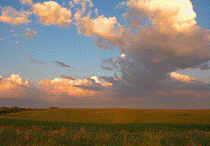North American Prairie Conference
Date of this Version
2004
Abstract
Oak (Quercus spp.) savanna, characterized by widely scattered oaks with an understory of prairie and other specialized species, is one of the most endangered native ecosystems in North America (Nuzzo 1986, Packard and MuteI 1997). The absence of grazing and burning along with the introduction of tillage agriculture are key factors for the loss of this ecosystem. Our objective was to determine the effectiveness of rotational grazing to reduce the shrub layer in degraded oak savannas. This study took place at three sites in southwestern Wisconsin. In this paper, we report on the results of the savanna grazing on the cattle. For two summers, cow/calf pairs or yearling Scottish Highland cattle (Bos taurus spp.) were placed on 1-acre (0.4-ha) treatment sites for two to three days per month with a rest on grass pasture for one day between replicates. Animal weight gain was satisfactory. During the study, cattle generally gained better in 2002 due to adjusted stocking densities from 2001. Cows that calved prior to the study typically maintained body weight similar to controls, while late~calving cows in both groups lost some weight. Dry cows, steers, and nursing calves also performed similar to the controls. Body condition scores (BCS) for all classes of cattle were similar between the treatment and control groups over the season, hovering around 5 and 6. Managed grazing with five to seven cow/calf pairs or 12 yearlings per acre, for two to three days per month two to four times per season reduced the shrub layer in oak savanna, while permitting adequate weight gains in the cattle.


Comments
Published in Dave Egan & John A. Harrington, editors, Proceedings of the 19th North American Prairie Conference: The Conservation Legacy Lives On..., University of Wisconsin-Madison, August 8-12, 2004 (Proceedings of the North American Prairie Conference, 19), Madison, WI: University of Wisconsin-Madison, 2004.